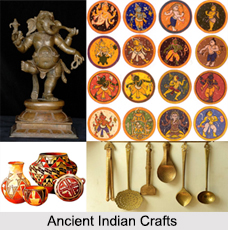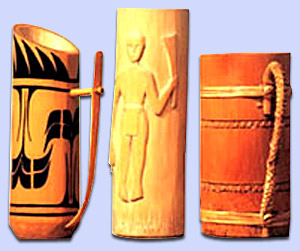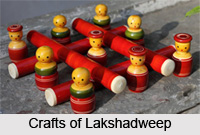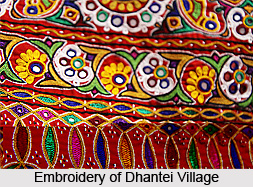 Ancient Indian crafts" forms have continuously evolved over thousands of years. From the time of the cosmos, the existence of craft is appeared in each sector of life. Sometimes it served the purpose of exchanging thoughts, sometimes to give shape to the learnt artistry and sometimes to satisfy the utilitarian needs to keep their food. The people of ancient India realized that they could have leisure after their regular schedule and to utilise the time they opted for some creative artworks that include pottery, jewellery making, statue making etc. As time advanced, people considered this art of craft as a profession. Later on influences from different dynasties, religions and emperors had helped to flourish the ancient craft and Indian craft as a whole.
Ancient Indian crafts" forms have continuously evolved over thousands of years. From the time of the cosmos, the existence of craft is appeared in each sector of life. Sometimes it served the purpose of exchanging thoughts, sometimes to give shape to the learnt artistry and sometimes to satisfy the utilitarian needs to keep their food. The people of ancient India realized that they could have leisure after their regular schedule and to utilise the time they opted for some creative artworks that include pottery, jewellery making, statue making etc. As time advanced, people considered this art of craft as a profession. Later on influences from different dynasties, religions and emperors had helped to flourish the ancient craft and Indian craft as a whole.
History of Indian Crafts
The account of Indian handicrafts goes back to roughly 5000 years from now. The practice of crafts in India has grown in the order of sacred values, needs of the general people and also the needs of the ruling leaders. There are several references in the Vedas of artisans involved in pottery making, weaving, wood craft etc. The Rig Veda consigns to a mixture of pottery made from terracotta, wood and metal. There is an allusion to weavers and weaving. In the Mauryan period there was huge growth in the field of carving. In this age, more than 84,000 stupas are said to be built in India, with the celebrated Sanchi Stupa, which has gorgeous stone carving and assistance work done on it.
The Gupta age saw fast development in the field of handicrafts and art forms. The murals at Ajanta and Ellora bear evidence to it. Throughout the Kushana period; jewellery, sculpture, material making, leather products, metal working etc. were the major handicrafts which assimilated foreign influences and used them in harmony with the Indian setting. In the Medieval era, the handicraftsmen flourished in the ground of pottery, weaving, wood carving, metal working, jewellery etc. The input of the Cholas and the Vijaynagar Empire in the field of bronze sculpture, silk weaving, jewellery, temple monument is just incomparable. The Mughal period was the golden period in the history of Indian art, craft and culture. The Mughals brought with them a prosperous heritage. The Mughals introduced methods like tile work, glass engraving, carpet weaving, brocades, enamelling, etc.
Growth of Crafts during Ancient India
Tamil states were the largely increasing era in the history of crafts and trade in ancient India. In Karimnagar in Telangana, carpenters, blacksmiths, goldsmiths, potters lived in part quarters and undeveloped and other labourers lived at one ending. Eight crafts were connected with the working of gold, silver, lead, tin, copper, brass, iron, and precious stones or jewels. A variety of types of crafts associated with cheek, zinc, antimony and red arsenic are also stated. Technological facts about iron work had made huge development and iron pieces have been determined in large numbers. The Telangana area of Andhra seems to have been the affluence in this respect and in accumulation to weapons, balance rods, sickles, ploughshares, razors and ladles have been discovered in the Karimnagar and Nalgonda districts of this area.
Mathura was a vast hub for the manufacture of a particular type of cloth which was called shataka. The manufacture of oil boosted because of the exercise of the oil wheel. The dedications of the age state weavers, goldsmiths, dyers, workers in metal and ivory, jewellers, sculptors, fishermen, smiths and perfumers as constructors of caves and also as donors of pillars, tablets, cisterns, etc. to the Buddhist monks. Indian ivories have been found in Afghanistan and Rome. They are related to ivory objects found in excavations at Satavahana sites in the Deccan. A coin shape from a Satavahana level demonstrates that it could produce half a dozen coins at a time. Coin moulding and other city handicrafts were complemented by the construct of beautiful pieces of terracotta, which flourish at several places. Most artisans recognized from inscriptions were confined to the Mathura province and to western Deccan which lay on the trade routes leading to the ports on the western coast.






